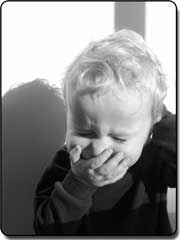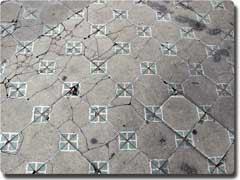Mold (An Overview)
 Mold and Moisture - Molds are living organisms that grow in damp shaded places. Their classification is part of the kingdom fungi. They are not truly a plant or an animal, instead showing characteristics of of both. Unlike plants, mold lacks chlorophyll and must survive by digesting plant material. Molds produce tiny spores in order to reproduce. There are hundreds of thousands of different types of mold and their spores are present almost everywhere. They will take root nearly anywhere there is moisture, organic materials, and oxygen. Molds that grow indoors have no seasonal pattern however outdoor molds are seasonal. These seasonal molds usually appear in early spring and survive until the winter frost.
Mold and Moisture - Molds are living organisms that grow in damp shaded places. Their classification is part of the kingdom fungi. They are not truly a plant or an animal, instead showing characteristics of of both. Unlike plants, mold lacks chlorophyll and must survive by digesting plant material. Molds produce tiny spores in order to reproduce. There are hundreds of thousands of different types of mold and their spores are present almost everywhere. They will take root nearly anywhere there is moisture, organic materials, and oxygen. Molds that grow indoors have no seasonal pattern however outdoor molds are seasonal. These seasonal molds usually appear in early spring and survive until the winter frost.
Role in Nature - Their role in nature is that of a decomposer since molds gradually destroy the things on which they grow. Without the presence of molds, our environment would be overwhelmed with large amounts of dead plant matter. As such they are an important part of the ecology since they break down dead organic matter such as fallen trees and dead leaves and turn them into fertilizer. Outdoors mold typically grows in moist shady areas like decaying vegetation, compost piles, on plants and trees, soil, rotting wood, and fallen leaves.
Mold Spores - Molds produce tiny spores which it uses to reproduce. They act as "seeds" and are used to spread the genetic material of the mold across a wide area. Mold spores can be found both indoor and outdoor looking for a damp dark spot with organic material on which to take root. Once they find favorable conditions they begin growing and digesting gradually destroying the organic materials and spreading its spores to surrounding areas with favorable conditions for growth until all resources have been consumed.
 Effects of Mold on People - Once mold takes root it stains or discolors surfaces and gives off a strong musty odor. In fact a musty smell may sometimes be the only evidence of their presence. The mold then releases a huge number of spores that float through the air of the home. There are a large number of molds that give off allergens, irritants, and sometimes toxins. Mold exposure can irritate the eyes, skin, nose, throat, and lungs whether you are allergic or not. These can cause health problems ranging from minor to severe when they are inhaled. The effect depends on the type of mold and the persons sensitivity. Mold affects everyone a bit differently so its effects can be difficult to predict. Mold can trigger asthma, repertory infections, or allergy attacks. Mold can also pose a serious health risk to individuals who have a compromised immune system or are particularly sensitive. For people that are sensitive to molds, exposure can cause symptoms like nasal congestion, sinus infection, eye irritation, wheezing, and itching from skin rash or other irritation. Some people may have more severe reactions. These reactions may include fever and shortness of breath. Some people may even develop mold infections in their lungs.
Effects of Mold on People - Once mold takes root it stains or discolors surfaces and gives off a strong musty odor. In fact a musty smell may sometimes be the only evidence of their presence. The mold then releases a huge number of spores that float through the air of the home. There are a large number of molds that give off allergens, irritants, and sometimes toxins. Mold exposure can irritate the eyes, skin, nose, throat, and lungs whether you are allergic or not. These can cause health problems ranging from minor to severe when they are inhaled. The effect depends on the type of mold and the persons sensitivity. Mold affects everyone a bit differently so its effects can be difficult to predict. Mold can trigger asthma, repertory infections, or allergy attacks. Mold can also pose a serious health risk to individuals who have a compromised immune system or are particularly sensitive. For people that are sensitive to molds, exposure can cause symptoms like nasal congestion, sinus infection, eye irritation, wheezing, and itching from skin rash or other irritation. Some people may have more severe reactions. These reactions may include fever and shortness of breath. Some people may even develop mold infections in their lungs.
Effects of Mold on You Home - Uncontrolled mold can cause some serious structural damage to your home. It can quickly decompose wood, drywall, carpeting and many other organic building materials leading to expensive repairs.
Toxic or Black Molds - Some molds, known as toxic molds, produce potent toxins that are poisonous and may be hazardous if people are exposed to them in large amounts. Toxic molds can cause a large amount of damage in a very short time when they are allowed to get a foothold and can cause some serious health problems. These toxins have been reported to cause symptoms like nose bleeds, lung bleeding, nausea, vomiting, and neurological disorders, like memory loss. Follow this link for more information on toxic or black mold.
Preventing Mold Growth in Your Home - There is no easy way to eliminate all of the mold spores in the indoor environment but you can limit their presence through the use of a good air filtration system. This will filter out many of the spores from the outdoor environment. However, if mold is allowed to take root indoors then no amount of filtration will keep the spores from adversely affecting the occupants. Molds need food and water to survive but since molds can use most organic material as food, the best way to prevent indoor mold growth is to control moisture. Humidity or wetness that is caused by water leaks or high humidity is the main cause of mold growth. Mold can also grow along walls where warm moist air condenses on cooler wall surfaces, like where objects like furniture are close to the wall. Some common sources of moisture are bathtubs, showers, condensation from your air conditioner, small water pipe leaks, leaky roofs, flooding, leaking toilets or sinks, improperly vented appliances, or many other sources can cause mold to grow. Uncontrolled humidity from a poorly functioning air conditioner or humidifier can also be a source of moisture and can also lead to mold growth, particularly in a hot, humid climate.
Where is it Found? - Indoor molds are typically found in dark, warm, humid, musty environments like cellars, attics, basements, bathrooms laundry rooms, refrigerators, garbage pails, and the inside of air conditioners and humidifiers.
 How to I clean up Mold? - If you find mold in your home clean up the mold as best you can and get rid of the source of the excess water or moisture. You can wash some molds off of a hard surface with detergent and water, and then dry the area completely preferable with a heat lamp to insure quick reduction of the moisture. Most absorbent materials will have to be replaced. Many mold problems are beyond the scope of a home repair and need a professional to address the problem.
How to I clean up Mold? - If you find mold in your home clean up the mold as best you can and get rid of the source of the excess water or moisture. You can wash some molds off of a hard surface with detergent and water, and then dry the area completely preferable with a heat lamp to insure quick reduction of the moisture. Most absorbent materials will have to be replaced. Many mold problems are beyond the scope of a home repair and need a professional to address the problem.
Click here to Order Parts from Ra-Jac Services Online Air-Conditioning and Heating Store
Take the guesswork out of shopping for high quality air conditioning and heating parts for your home or office. We offer only top quality parts that the professionals are using. Let our 40+ years in the air conditioning, heating, ventilation and refrigeration industry work for you.
Ra-Jac Air Conditioning & Heating has proudly served Galveston County TX since 1966. We pride ourselves on providing top notch service on residential and commercial air conditioning, heating, and refrigeration in the Southern Texas area.
We offer prompt and courteous service on air conditioning, heating, and refrigeration equipment.
Algoa / Arcadia / Bacliff / Bayou Vista / Clear Lake City / Clear Lake Shores / Dickinson / El Lago / Friendswood / Galveston / Hitchcock / Kemah / La Marque / League City / Nasa Area / Nassau Bay / San Leon / Santa Fe / Seabrook / Taylor Lake Village / Texas City / Tiki Island / Webster

